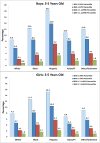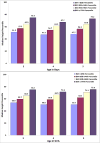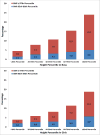Prevalence of obesity and extreme obesity in children aged 3-5 years
- PMID: 23677690
- PMCID: PMC3830709
- DOI: 10.1111/j.2047-6310.2013.00154.x
Prevalence of obesity and extreme obesity in children aged 3-5 years
Abstract
Background: Early childhood adiposity may have significant later health effects. This study examines the prevalence and recognition of obesity and severe obesity among preschool-aged children.
Methods: The electronic medical record was used to examine body mass index (BMI), height, sex and race/ethnicity in 42,559 children aged 3-5 years between 2007 and 2010. Normal or underweight (BMI < 85th percentile); overweight (BMI 85th-94th percentile); obesity (BMI ≥ 95th percentile); and severe obesity (BMI ≥ 1.2 × 95th percentile) were classified using the 2000 Centers for Disease Control and Prevention growth charts. Provider recognition of elevated BMI was examined for obese children aged 5 years.
Results: Among 42,559 children, 12.4% of boys and 10.0% of girls had BMI ≥ 95th percentile. The prevalence was highest among Hispanics (18.2% boys, 15.2% girls), followed by blacks (12.4% boys, 12.7% girls). A positive trend existed between increasing BMI category and median height percentile, with obesity rates highest in the highest height quintile. The prevalence of severe obesity was 1.6% overall and somewhat higher for boys compared with girls (1.9 vs. 1.4%, P < 0.01). By race/ethnicity, the highest prevalence of severe obesity was seen in Hispanic boys (3.3%). Among those aged 5 years, 77.9% of obese children had provider diagnosis of obesity or elevated BMI, increasing to 89.0% for the subset with severe obesity.
Conclusions: Obesity and severe obesity are evident as early as age 3-5 years, with race/ethnic trends similar to older children. This study underscores the need for continued recognition and contextualization of early childhood obesity in order to develop effective strategies for early weight management.
Keywords: Children; obesity; preschool; severe obesity.
© 2013 The Authors. Pediatric Obesity © 2013 International Association for the Study of Obesity.
Conflict of interest statement
Figures



References
-
- Barlow SE. Expert committee recommendations regarding the prevention, assessment, and treatment of child and adolescent overweight and obesity: summary report. Pediatrics. 2007;120(4):S164–92. - PubMed
-
- Ogden CL, Lamb MM, Carroll MD, Flegal KM. NCHS Data Brief. 2010. Obesity and socioeconomic status in children and adolescents: United States, 2005-2008; pp. 1–8. - PubMed
-
- Ogden CL, Carroll MD, Curtin LR, Lamb MM, Flegal KM. Prevalence of high body mass index in US children and adolescents, 2007-2008. JAMA. 2010;303:242–9. - PubMed
-
- Ogden CL, Carroll MD, Flegal KM. High body mass index for age among US children and adolescents, 2003-2006. JAMA. 2008;299:2401–5. - PubMed
Publication types
MeSH terms
Grants and funding
LinkOut - more resources
Full Text Sources
Other Literature Sources
Medical

